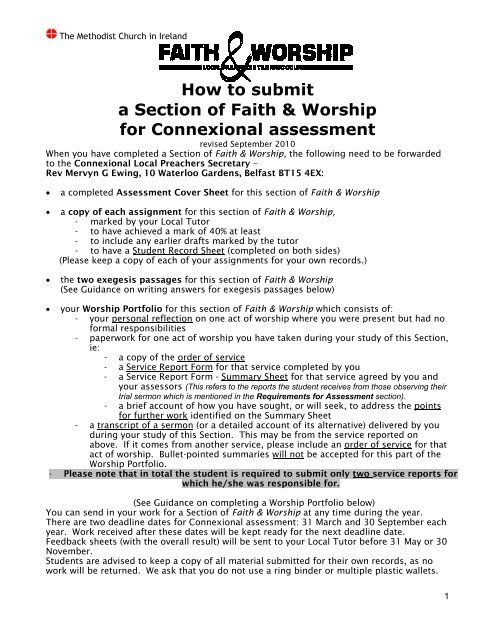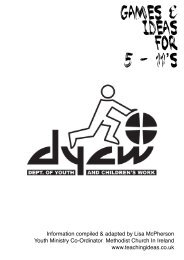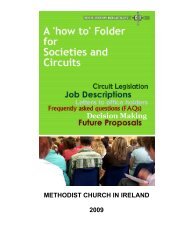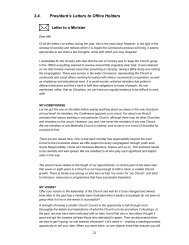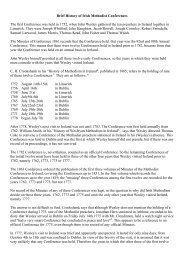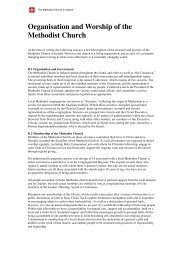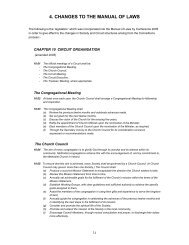How to submit a Section of Faith & Worship for Assessment
How to submit a Section of Faith & Worship for Assessment
How to submit a Section of Faith & Worship for Assessment
You also want an ePaper? Increase the reach of your titles
YUMPU automatically turns print PDFs into web optimized ePapers that Google loves.
The Methodist Church in Ireland<br />
<strong>How</strong> <strong>to</strong> <strong>submit</strong><br />
a <strong>Section</strong> <strong>of</strong> <strong>Faith</strong> & <strong>Worship</strong><br />
<strong>for</strong> Connexional assessment<br />
revised September 2010<br />
When you have completed a <strong>Section</strong> <strong>of</strong> <strong>Faith</strong> & <strong>Worship</strong>, the following need <strong>to</strong> be <strong>for</strong>warded<br />
<strong>to</strong> the Connexional Local Preachers Secretary –<br />
Rev Mervyn G Ewing, 10 Waterloo Gardens, Belfast BT15 4EX:<br />
• a completed <strong>Assessment</strong> Cover Sheet <strong>for</strong> this section <strong>of</strong> <strong>Faith</strong> & <strong>Worship</strong><br />
• a copy <strong>of</strong> each assignment <strong>for</strong> this section <strong>of</strong> <strong>Faith</strong> & <strong>Worship</strong>,<br />
- marked by your Local Tu<strong>to</strong>r<br />
- <strong>to</strong> have achieved a mark <strong>of</strong> 40% at least<br />
- <strong>to</strong> include any earlier drafts marked by the tu<strong>to</strong>r<br />
- <strong>to</strong> have a Student Record Sheet (completed on both sides)<br />
(Please keep a copy <strong>of</strong> each <strong>of</strong> your assignments <strong>for</strong> your own records.)<br />
• the two exegesis passages <strong>for</strong> this section <strong>of</strong> <strong>Faith</strong> & <strong>Worship</strong><br />
(See Guidance on writing answers <strong>for</strong> exegesis passages below)<br />
• your <strong>Worship</strong> Portfolio <strong>for</strong> this section <strong>of</strong> <strong>Faith</strong> & <strong>Worship</strong> which consists <strong>of</strong>:<br />
- your personal reflection on one act <strong>of</strong> worship where you were present but had no<br />
<strong>for</strong>mal responsibilities<br />
- paperwork <strong>for</strong> one act <strong>of</strong> worship you have taken during your study <strong>of</strong> this <strong>Section</strong>,<br />
ie:<br />
- a copy <strong>of</strong> the order <strong>of</strong> service<br />
- a Service Report Form <strong>for</strong> that service completed by you<br />
- a Service Report Form - Summary Sheet <strong>for</strong> that service agreed by you and<br />
your assessors (This refers <strong>to</strong> the reports the student receives from those observing their<br />
trial sermon which is mentioned in the Requirements <strong>for</strong> <strong>Assessment</strong> section).<br />
- a brief account <strong>of</strong> how you have sought, or will seek, <strong>to</strong> address the points<br />
<strong>for</strong> further work identified on the Summary Sheet<br />
- a transcript <strong>of</strong> a sermon (or a detailed account <strong>of</strong> its alternative) delivered by you<br />
during your study <strong>of</strong> this <strong>Section</strong>. This may be from the service reported on<br />
above. If it comes from another service, please include an order <strong>of</strong> service <strong>for</strong> that<br />
act <strong>of</strong> worship. Bullet-pointed summaries will not be accepted <strong>for</strong> this part <strong>of</strong> the<br />
<strong>Worship</strong> Portfolio.<br />
- Please note that in <strong>to</strong>tal the student is required <strong>to</strong> <strong>submit</strong> only two service reports <strong>for</strong><br />
which he/she was responsible <strong>for</strong>.<br />
(See Guidance on completing a <strong>Worship</strong> Portfolio below)<br />
You can send in your work <strong>for</strong> a <strong>Section</strong> <strong>of</strong> <strong>Faith</strong> & <strong>Worship</strong> at any time during the year.<br />
There are two deadline dates <strong>for</strong> Connexional assessment: 31 March and 30 September each<br />
year. Work received after these dates will be kept ready <strong>for</strong> the next deadline date.<br />
Feedback sheets (with the overall result) will be sent <strong>to</strong> your Local Tu<strong>to</strong>r be<strong>for</strong>e 31 May or 30<br />
November.<br />
Students are advised <strong>to</strong> keep a copy <strong>of</strong> all material <strong>submit</strong>ted <strong>for</strong> their own records, as no<br />
work will be returned. We ask that you do not use a ring binder or multiple plastic wallets.<br />
1
The Methodist Church in Ireland<br />
<strong>Worship</strong> Portfolio<br />
Your personal reflection on one act <strong>of</strong> worship where you were present but had<br />
no <strong>for</strong>mal responsibilities.<br />
Please give us a few facts that will help put your personal reflection in context eg: place,<br />
date and time, numbers, age range. Then write your reflection (300-500 words)<br />
remembering that the emphasis needs <strong>to</strong> be on your understanding and evaluation <strong>of</strong> what<br />
happened rather than just describing what happened. To do this well, try answering<br />
questions that start <strong>How</strong>? or Why? <strong>to</strong> show UNDERSTANDING and questions that start <strong>How</strong><br />
well? or <strong>How</strong> appropriate? and even <strong>How</strong> do I compare? <strong>to</strong> show EVALUATION. If you’re not<br />
sure what <strong>to</strong> comment on, a Service Report Form could give you some ideas. Here’s an<br />
example <strong>of</strong> personal reflection on one act <strong>of</strong> worship. Can you spot evidence <strong>of</strong><br />
understanding? Can you find evaluative comments? (Please note: there is no <strong>of</strong>ficial <strong>for</strong>m <strong>to</strong><br />
record your reflection.)<br />
Ballygosomewhere Methodist Church<br />
14 February, 10am<br />
Congregation <strong>of</strong> 50 people—half adults, half children<br />
Adults ages: 30-75, Children ages: babies -15<br />
Multi-cultural, multi-ethnic<br />
In addition <strong>to</strong> someone welcoming people at the door as they came in, the<br />
preacher also personally greeted people, moving round the church <strong>to</strong> do so.<br />
The preacher was very warm and caring in his manner, demonstrating God’s<br />
love and concern <strong>for</strong> each individual.<br />
There was a lot <strong>of</strong> participation in the service—several members <strong>of</strong> the<br />
congregation shared in the worship by bringing the scripture readings,<br />
leading the contemporary singing, taking up the <strong>of</strong>fering, and bringing an<br />
interactive all-age message. This reminds us that worship is a joint<br />
celebration <strong>of</strong> who God is and what he’s done, that worship is active, and thus<br />
helps the whole congregation <strong>to</strong> be actively involved in the worship.<br />
Being Valentine’s Day, the theme <strong>of</strong> the service was Love. Instead <strong>of</strong> a<br />
children’s message a member <strong>of</strong> the congregation brought an all-age<br />
message based on the word Love. The congregation were divided in<strong>to</strong> four<br />
groups and each group had <strong>to</strong> think <strong>of</strong> words that describe God’s love<br />
beginning with L, with O, with V and with E, i.e. beginning with each <strong>of</strong> the<br />
letters in the word love. Each group then shared their ideas which were<br />
written up on a flipchart. This was a really good way <strong>to</strong> get the congregation<br />
actively involved including the children—even the young ones were able <strong>to</strong><br />
call out words that their parents <strong>to</strong>ld them—and <strong>to</strong> get everyone working<br />
<strong>to</strong>gether. It made us s<strong>to</strong>p and think about what God’s love is really like. This<br />
practical way <strong>of</strong> reflecting is a good way <strong>to</strong> help us internalise truths about<br />
God.<br />
The sermon was based on a well-known passage <strong>of</strong> scripture 1 Corinthians<br />
13. Whilst it probably contained important truths, it was not memorable. I<br />
think that a sermon should help <strong>to</strong> deepen our understanding <strong>of</strong> God, in order<br />
2
The Methodist Church in Ireland<br />
<strong>to</strong> deepen our faith and draw us in<strong>to</strong> a closer relationship with God; I feel<br />
challenged <strong>to</strong> think about how <strong>to</strong> do this whilst preaching a sermon based on<br />
very familiar passages. <strong>How</strong> do I bring something fresh? Something the<br />
congregation can apply in their everyday lives.<br />
Your personal reflection will be marked out <strong>of</strong> 20:<br />
- 10 marks <strong>for</strong> understanding<br />
- 10 marks <strong>for</strong> evaluation<br />
Paperwork <strong>for</strong> one act <strong>of</strong> worship you have taken<br />
during your study <strong>of</strong> this section<br />
This must include:<br />
• A copy <strong>of</strong> the order <strong>of</strong> service<br />
You will have prepared this anyway, so it’s just a case <strong>of</strong> remembering <strong>to</strong> keep it in your<br />
<strong>Worship</strong> Portfolio.<br />
• A Service Report Form <strong>for</strong> that service completed by you<br />
You and each <strong>of</strong> your assessors should have a Service Report Form <strong>to</strong> complete after the<br />
service you have taken (as a normal part <strong>of</strong> reporting <strong>for</strong> the Circuit Local Preachers’<br />
Meeting). This helps each <strong>of</strong> you bring your own thoughts and perspectives when you<br />
meet <strong>to</strong> agree the Summary Sheet. Only the Service Report Form that you have<br />
completed needs <strong>to</strong> be kept in your <strong>Worship</strong> Portfolio.<br />
• A Service Report Form - Summary Sheet <strong>for</strong> that service agreed by you and your<br />
assessors (normally a preacher and a church steward)<br />
The Summary Sheet draws <strong>to</strong>gether the thoughts and reflections <strong>of</strong> the preacher and the<br />
assessors. This process is particularly helpful when all involved share their perceptions,<br />
consider their responses and come <strong>to</strong> an agreed evaluation. Some points on this sheet<br />
may be similar <strong>to</strong> the points you’ve made on your own Service Report Form, but others<br />
may be rather different. For example, there might be mention <strong>of</strong> something you’ve<br />
overlooked or taken <strong>for</strong> granted. There might be pointers <strong>for</strong> further development that<br />
were easier <strong>to</strong> spot in the pew than in the pulpit. There might be encouragement and<br />
praise that you would not have given yourself. A copy <strong>of</strong> this Summary Sheet will go <strong>to</strong><br />
the Local Preachers’ Meeting, but you’ll also need a copy <strong>for</strong> your <strong>Worship</strong> Portfolio.<br />
• A brief account <strong>of</strong> how you have sought, or will seek, <strong>to</strong> address the points <strong>for</strong> further<br />
work identified on the Summary Sheet<br />
You could write this on the back <strong>of</strong> the Summary Sheet. It’s worth discussing this with<br />
your assessors as you all complete the Summary Sheet anyway. For example, it’s all very<br />
well identifying a need <strong>for</strong> voice projection but the assessors and/or the Local Preachers’<br />
Meeting should also suggest who could help you. Your ‘brief account’ on addressing the<br />
‘points <strong>for</strong> further work’ will clarify who will do what by when (or who has done what<br />
already!)<br />
3
The Methodist Church in Ireland<br />
Your Service Report Form will receive comments with reference <strong>to</strong> the order <strong>of</strong> service,<br />
the Summary Sheet and your brief account on addressing the ‘points <strong>for</strong> further work’. It<br />
will be treated rather like your Personal Reflection on another’s service, but this time the<br />
Service Report Form’s questions give you a detailed agenda <strong>to</strong> work <strong>to</strong>.<br />
Assessors will look <strong>for</strong> understanding (<strong>of</strong> what the Service Report Form is asking you <strong>to</strong><br />
make comment) and evaluation (your assessment <strong>of</strong> how well different aspects <strong>of</strong> the<br />
service went). They will <strong>of</strong>fer comment, but not award marks.<br />
• A transcript <strong>of</strong> a sermon (or a detailed account <strong>of</strong> its alternative) delivered by you<br />
during your study <strong>of</strong> this <strong>Section</strong>. This may be from the service reported on above. If it<br />
comes from another service, please include an order <strong>of</strong> service <strong>for</strong> that act <strong>of</strong> worship.<br />
Bullet-pointed summaries will not be accepted <strong>for</strong> this part <strong>of</strong> the <strong>Worship</strong> Portfolio.<br />
If you have preached a sermon from a full script, then it’s the full script that goes in<strong>to</strong><br />
your <strong>Worship</strong> Portfolio. If you have preached from notes, then the notes themselves are<br />
not enough. A tape-recording <strong>of</strong> the sermon given <strong>to</strong> an audio-typist would be the<br />
quickest way <strong>to</strong> get a transcript. If you have conveyed the Good News in alternative ways<br />
(rather than a sermon), then a detailed account <strong>of</strong> what was said and done needs <strong>to</strong> go<br />
in<strong>to</strong> your <strong>Worship</strong> Portfolio. Whichever approach you take, this part <strong>of</strong> the <strong>Worship</strong><br />
Portfolio <strong>of</strong>fers evidence <strong>of</strong> how you share the Good News with a congregation.<br />
Assessors will look <strong>for</strong> and comment on some or all <strong>of</strong> the following:<br />
- clarity <strong>of</strong> aim<br />
- creativity<br />
- how the content relates <strong>to</strong> Biblical material<br />
- how the content relates <strong>to</strong> <strong>to</strong>day<br />
Exegesis<br />
Each year in the August letter <strong>to</strong> Local Tu<strong>to</strong>rs will appear a list <strong>of</strong> two Bible passages <strong>for</strong> each<br />
<strong>Section</strong> <strong>of</strong> <strong>Faith</strong> & <strong>Worship</strong> <strong>for</strong> the following calendar year’s Connexional <strong>Assessment</strong> (31<br />
March and 30 September). The list will also appear in the Methodist Newsletter in early<br />
autumn. Please note that exegesis passages are section and year specific: if you miss the<br />
deadline <strong>for</strong> any September assessment, you will need <strong>to</strong> re-write your exegesis passages <strong>to</strong><br />
match those set <strong>for</strong> the following year.<br />
On page 28 <strong>of</strong> Unit 2 <strong>of</strong> <strong>Faith</strong> & <strong>Worship</strong>, there is a diagram <strong>for</strong> sermon preparation. The<br />
notes on the next few pages explain how the diagram relates <strong>to</strong> exegesis in assignments and<br />
in Connexional <strong>Assessment</strong>. The following <strong>for</strong>mat is used:<br />
For a given passage:<br />
a. outline its context and background<br />
b. indicate its original meaning<br />
c. consider its message <strong>for</strong> us <strong>to</strong>day in the light <strong>of</strong> its context, background<br />
and original meaning<br />
4
The Methodist Church in Ireland<br />
In the Connexional assessment, each Bible passage will be marked out <strong>of</strong> 30:<br />
a. 8 marks (knowledge)<br />
b. 10 marks (understanding)<br />
c. 12 marks (application)<br />
You have <strong>to</strong> reach the pass mark <strong>of</strong> 40% (12 marks out <strong>of</strong> 30) <strong>for</strong> each Bible passage. This<br />
guidance aims <strong>to</strong> help you do much better than that!<br />
A suggested word count is 600-1000 words <strong>for</strong> each exegesis.<br />
a. Outline its context and background<br />
This part refers <strong>to</strong> the first and third set <strong>of</strong> questions in the ‘Exegesis’ segment <strong>of</strong> the<br />
diagram on page 28 <strong>of</strong> Unit 2:<br />
• Context: Why is this Bible passage where it is?<br />
What comes be<strong>for</strong>e it and after?<br />
• Background: What is the cultural background <strong>of</strong> this passage?<br />
What type <strong>of</strong> literature is it?<br />
What do we know <strong>of</strong> its author and the audience <strong>for</strong> whom it was<br />
intended?<br />
Here, your answers are assessed <strong>for</strong> KNOWLEDGE.<br />
You may choose <strong>to</strong> deal with background first eg:<br />
- Author: who was speaking/writing when, about what<br />
- Type <strong>of</strong> literature: eg: law, his<strong>to</strong>ry, poetry, prophecy, gospel, letter, escha<strong>to</strong>logy,<br />
parable, saying, miracle s<strong>to</strong>ry, argument<br />
- Audience: who the audience was<br />
There is no need <strong>for</strong> great detail. Usually, a few sentences will be enough <strong>to</strong> provide the<br />
relevant in<strong>for</strong>mation.<br />
Once this is done, you can deal with context:<br />
- Be<strong>for</strong>e and after: what ground the previous and subsequent verses cover<br />
how this passage affirms/contrasts with the verses around it<br />
- Sources: in some cases there may be a need <strong>to</strong> mention where a passage<br />
comes from, or how there is a similar passage <strong>to</strong> this elsewhere,<br />
or how an edi<strong>to</strong>r’s hand is evident<br />
5
The Methodist Church in Ireland<br />
Again, this can be done concisely. It is helpful if descriptions <strong>of</strong> context throw light on the<br />
passage in question rather than restate in detail what comes be<strong>for</strong>e and after. It is also<br />
worthwhile simply noting in<strong>for</strong>mation about sources that help show the particular emphasis<br />
or <strong>to</strong>ne <strong>of</strong> the passage. Avoid delving in<strong>to</strong> fascinating facts and comparisons.<br />
b. Indicate its original meaning<br />
This part <strong>of</strong> the question refers <strong>to</strong> the second set <strong>of</strong> questions in the ‘Exegesis’ part <strong>of</strong> the<br />
diagram on page 28 <strong>of</strong> Unit 2:<br />
• Meaning What might it have meant <strong>to</strong> the original hearers/readers?<br />
What reactions did it provoke then and why?<br />
Here, answers are assessed <strong>for</strong> UNDERSTANDING. Answers are likely <strong>to</strong> cover at least some<br />
<strong>of</strong> the following points:<br />
- what the author may have meant or what the audience may have unders<strong>to</strong>od<br />
- (especially referring <strong>to</strong> how key words/themes appear in the passage)<br />
- what theological ideas appear in the passage<br />
It may not be possible <strong>to</strong> keep these elements separate. In fact, it may be better if they are<br />
closely linked. For example, <strong>to</strong> say ‘kingdom <strong>of</strong> God’ is a key idea without explaining<br />
meaning(s) <strong>of</strong> the phrase makes it hard <strong>for</strong> a local tu<strong>to</strong>r or a Connexional Assessor <strong>to</strong> give<br />
credit <strong>for</strong> understanding. Many passages <strong>of</strong>fer more than one theological idea, so an answer<br />
which limits itself <strong>to</strong> one point and misses others is weak, even if the one point is explained<br />
well.<br />
Answers are strong when they show that not only has the Bible passage been read and<br />
considered, but also that views and understandings <strong>of</strong> others (<strong>for</strong> example, in the unit and in<br />
commentaries) have been taken in<strong>to</strong> account as well.<br />
c. Consider its message <strong>for</strong> us <strong>to</strong>day in the light <strong>of</strong> its context,<br />
background and original meaning.<br />
This part <strong>of</strong> the question needs <strong>to</strong> draw on the ‘Preacher’ and ‘People’ segments <strong>of</strong> the<br />
diagram on page 28 <strong>of</strong> Unit 2.<br />
• Individual What echoes are there in this Bible passage <strong>for</strong> me?<br />
(‘Preacher’) Are there links with my own s<strong>to</strong>ry?<br />
Does this passage raise questions <strong>for</strong> me?<br />
Does the passage challenge, confront or confirm me?<br />
• Community What echoes are there in this Bible passage <strong>for</strong> a congregation or<br />
(‘People’) community?<br />
Are there links with these people’s own s<strong>to</strong>ry or experience?<br />
6
The Methodist Church in Ireland<br />
What words or ideas may stand out <strong>for</strong> those who hear it?<br />
What questions might be raised by this passage?<br />
Does the passage <strong>of</strong>fer a critique or confirmation <strong>to</strong> the contemporary<br />
world?<br />
Here, answers are assessed <strong>for</strong> APPLICATION (how well the message is applied <strong>to</strong> the<br />
contemporary [and perhaps local] situation yet with due care <strong>to</strong> honour the sense <strong>of</strong><br />
direction and purpose learned from considering the passage’s context, background and<br />
original meaning).<br />
Although the questions addressed <strong>to</strong> the ‘Preacher’ may throw fresh light or searching<br />
questions <strong>for</strong> the preacher on the passage, these should only be used <strong>to</strong> alert the preacher<br />
<strong>to</strong> how the message can be applied <strong>to</strong> the contemporary circumstances the congregation is<br />
facing. They might spark an idea <strong>for</strong> an illustration from personal experience, but the focus<br />
should be primarily on the ‘People’ questions.<br />
Answers are strong when they show that the passage can become a lens through which<br />
contemporary situations are seen in sharp relief.<br />
Applying the diagram <strong>to</strong> an assignment or examination question<br />
An assignment or examination question might <strong>of</strong>fer only one or two verses <strong>for</strong> exegesis and<br />
interpretation, so the following answer is based on Matthew 13: 31 - 35 (NIV):<br />
Exegesis:<br />
a. Outline its context and background.<br />
Matthew would have been writing <strong>for</strong> a Jewish audience and there<strong>for</strong>e the word ‘God’ would have<br />
been avoided and so he writes about the ‘kingdom <strong>of</strong> heaven.’ Matthew emphasises that Jesus<br />
was the fulfilment <strong>of</strong> the OT prophecies, presenting Him as their true King.<br />
Chapter 13 is a collection <strong>of</strong> seven parables <strong>of</strong> the kingdom. Tension has been rising in the<br />
previous two chapters, where the narrative has explored the nature <strong>of</strong> Jesus’ messiahship and<br />
there has been confrontation with the Pharisees in response <strong>to</strong> a controversial healing on the<br />
Sabbath. Jesus does not seek publicity, indeed he discourages anyone that he healed not <strong>to</strong> “tell<br />
who he was” and in 12:18 – 21 he quotes from Isaiah 42: 1 – 4 which outlines his ministry <strong>to</strong> the<br />
outcast and ultimately <strong>to</strong> the Gentiles. 13:53 – 17:27 records the build up <strong>of</strong> conflict with Jewish<br />
leaders which lead up <strong>to</strong> the rejection and death <strong>of</strong> Jesus.<br />
Matthew 13:2 reveals that Jesus was surrounded by such large crowds that he had <strong>to</strong> get “in<strong>to</strong> a<br />
boat and sat in it while all the people s<strong>to</strong>od on the shore”. He taught them in parables. The<br />
disciples didn’t understand these parables and Jesus interprets them <strong>for</strong> them, saying in v11<br />
“The knowledge <strong>of</strong> the kingdom <strong>of</strong> heaven has been given <strong>to</strong> you, but not <strong>to</strong> them.” He quotes<br />
from Isaiah 6:9, 10 that “You will be ever hearing but never understanding, you will be ever<br />
seeing but never perceiving. For this people’s heart has become calloused;...” The crowd would<br />
have been Jewish, among them Pharisees, who were living under the rule <strong>of</strong> the pagan Roman<br />
Empire. By teaching in parables Jesus can effectively challenge those whose imagination was<br />
7
The Methodist Church in Ireland<br />
bound by the expectations they had <strong>of</strong> the Messiah and what he would do. The parables were<br />
provocative, breaking through the present reality <strong>to</strong> reveal a new vision <strong>of</strong> the Kingdom <strong>of</strong> God.<br />
b. Indicate its original meaning.<br />
The mustard seed and the yeast - parables <strong>of</strong> growth<br />
These two short parables contrast the small beginning <strong>of</strong> the kingdom with the greatness <strong>of</strong> its<br />
effects. God’s kingdom has secret power which confounds the wisdom <strong>of</strong> the world. The parables<br />
remind us <strong>of</strong> the humility in which God’s kingdom is established.<br />
Why did Jesus choose a mustard seed? The mustard seed is tiny, but is not, in fact, the smallest<br />
<strong>of</strong> all seeds. The shrub that grows from the tiny seed is great by comparison with its beginnings,<br />
the mustard shrub typically grows <strong>to</strong> between 8 and 12 feet, but this is hardly comparable <strong>to</strong> the<br />
mighty cedars <strong>of</strong> Lebanon, with which Israel preferred <strong>to</strong> liken itself.<br />
Daniel 4: 10 – 12 speaks <strong>of</strong> a vision <strong>of</strong> an enormous tree standing in the middle <strong>of</strong> the land, with<br />
beautiful leaves, fruit <strong>for</strong> all and under it shelter <strong>for</strong> the beasts <strong>of</strong> the field and the birds living in<br />
its branches.<br />
Ezekiel 17:23 is similar, only the tree is named as a might cedar.<br />
An observant Jew would have been struck by the unorthodox nature <strong>of</strong> the very act <strong>of</strong> sowing a<br />
mustard seed in a field. It would have been viewed as an <strong>of</strong>fense against God’s covenant with<br />
Israel. Lev 19:19 <strong>for</strong>bids planting your field with two kinds <strong>of</strong> seed.<br />
Mustard is an invasive plant – so there’s an uncontrollable aspect <strong>of</strong> the Kingdom <strong>of</strong> God. It’s<br />
less <strong>to</strong> do with our initiative but more <strong>to</strong> do with our cooperation with God’s Spirit.<br />
To an Eastern mind, the image <strong>of</strong> a seed growing would be a mysterious miracle. In 1 Cor 15:35<br />
– 38, the seed is an image <strong>of</strong> the resurrection, showing the mystery <strong>of</strong> new life following death.<br />
The mustard seed is also used as a metaphor <strong>for</strong> personal faith in Matt 17:20.<br />
Mustard has a pungent taste and was also used <strong>for</strong> medicinal and seasoning purposes so maybe<br />
there’s the idea <strong>of</strong> the Kingdom <strong>of</strong> God being a source <strong>of</strong> healing.<br />
The mention <strong>of</strong> the birds perching in the branches could also allude <strong>to</strong> the tree image from<br />
Daniel & Ezekiel and so subverting the whole idea <strong>of</strong> self-aggrandizement. The birds would have<br />
likely been unwanted pests in a planted field where they would eat seeds. Birds were considered<br />
unclean so could these unwelcome visi<strong>to</strong>rs include the gentiles?<br />
So the original meaning <strong>of</strong> the mustard shrub is that that God brings great things out <strong>of</strong> small<br />
beginnings, but that we should not expect his kingdom <strong>to</strong> be great as the world counts greatness.<br />
There’ll be an element <strong>of</strong> surprise, <strong>of</strong> crossing boundaries and challenge <strong>to</strong> our love <strong>of</strong> control &<br />
power.<br />
Leaven is old, fermented dough which is used as a raising agent. It would have been considered<br />
as a symbol <strong>for</strong> moral corruption.<br />
1 Cor 5:6, 7<br />
6 Your boasting is not good. Don't you know that a little yeast works through the whole batch <strong>of</strong> dough?<br />
8
The Methodist Church in Ireland<br />
7 Get rid <strong>of</strong> the old yeast that you may be a new batch without yeast—as you really are. For Christ, our<br />
Passover lamb, has been sacrificed. 8 There<strong>for</strong>e let us keep the Festival, not with the old yeast, the<br />
yeast <strong>of</strong> malice and wickedness, but with bread without yeast, the bread <strong>of</strong> sincerity and truth.<br />
Also, Gal 5:9 9 "A little yeast works through the whole batch <strong>of</strong> dough."<br />
In Matthew 16: 6 6 "Be careful," Jesus said <strong>to</strong> them. "Be on your guard against the yeast <strong>of</strong> the<br />
Pharisees and Sadducees." What he is warning about is the teaching <strong>of</strong> the Pharisees and<br />
Sadducees which was essentially petty, used <strong>to</strong> control and also sectarian.<br />
Unleavened bread was used in the Passover and in the Temple and symbolised what was holy and<br />
sacred.<br />
The quantity <strong>of</strong> the flour is excessive. The bread would provide a meal <strong>for</strong> over 100 people so is<br />
Jesus suggesting a feast? Jesus was criticised by the Pharisees <strong>for</strong> mixing with sinners and not<br />
fasting.<br />
Women would have been considered unclean, religiously impure – someone on the margins.<br />
In the Greek, the verb is not kneading (phyrao) but hides (kryp<strong>to</strong> in Luke & egkryp<strong>to</strong> in Matt) so<br />
there’s a sinister feel <strong>to</strong> what’s going on.<br />
So there is a challenge here <strong>to</strong> recognise that he kingdom <strong>of</strong> God will not take place where people<br />
are concerned about remaining holy and uncorrupted by the world. Reaching out in love,<br />
compassion, reconciliation and <strong>for</strong>giveness is more important in God’s eyes than moral<br />
incorruption. The Kingdom <strong>of</strong> God is active in the ordinary and almost in unnoticeable ways but<br />
the effects will be huge, sometimes taking us by surprise.<br />
The parable <strong>of</strong> the leaven also encourages us <strong>to</strong> avoid seclusion and <strong>to</strong> be involved in the world.<br />
Leaven works as it is worked in<strong>to</strong> the dough.<br />
c. Consider its message <strong>for</strong> the congregation you have described.<br />
As an encouragement – that God brings great things out <strong>of</strong> small beginnings. It’s beyond our<br />
control. It spreads not through mighty campaigns and crusades but in hidden and seditious<br />
ways. Not <strong>to</strong> expect the kingdom <strong>to</strong> be great as the world counts greatness. We can expect God<br />
<strong>to</strong> use small and trivial beginnings <strong>to</strong> trans<strong>for</strong>m the world in unexpected, disruptive and nonviolent<br />
ways.<br />
To realise the boundary breaker that Jesus was. To consider what boundaries we erect or<br />
preserve. To be open <strong>to</strong> those who are different from us – especially those whom we would<br />
consider undesirable or unholy. The kingdom belongs <strong>to</strong> those who are on the edge, the poor,<br />
disenfranchised, invisible people. It overturns the self-serving interests <strong>of</strong> the ruling elites. It’s<br />
not about us staying in a ‘holy huddle’ away from those who don’t live good moral lives like us.<br />
This is a challenge <strong>to</strong> us in church when we’re all nice and middle class.<br />
Not just <strong>to</strong> think about what Jesus says but <strong>to</strong> act upon it. The parables give us a sense <strong>of</strong><br />
direction. We cannot build the kingdom but we can pray <strong>for</strong> it, practice the kingdom in our daily<br />
lives. We can take this parable home and let it be the starting point and ask God <strong>to</strong> show us what<br />
it means <strong>for</strong> us.<br />
9


